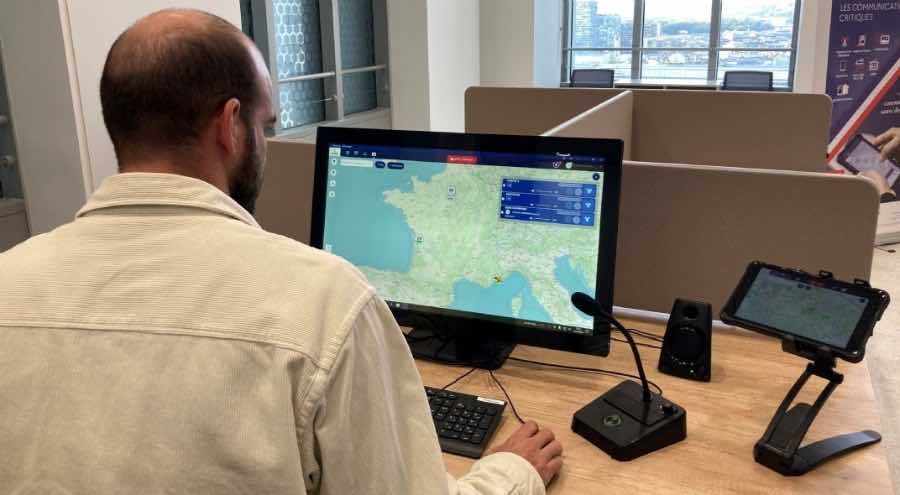
Several dozen security and emergency services are already involved in deploying the "Radio Network of the Future," according to ACMOSS (Agency for Operational Mobile Communications for Security and Emergency Services). This high-speed communication service, based on the 4G and 5G infrastructure of commercial network operators, is set to replace current operational communication networks starting in April 2025. The aim is to reach at least 300,000 mobile subscribers by the end of 2027, according to Guillaume Lambert, the director of ACMOSS.
A Decade in the Making
In its Liberty Tower offices in La Défense, freshly set up in autumn 2024, ACMOSS is gearing up for the April 2025 launch of the "Radio Network of the Future" (RRF). Initiated a decade ago and backed by €900 million in state funding between 2020 and 2030, the RRF aims to "revitalize operational communication capacities for services contributing to missions such as security, emergency medical aid, population protection, and crisis management," explains Guillaume Lambert. The RRF leverages 4G and 5G technology to replace existing networks like Tetrapol, a system dating back to the 1990s.
The RRF relies on 4G and 5G infrastructure from Orange and Bouygues Telecom, incorporating technical specifications that ensure robust critical communications and prioritization during network congestion. It also offers roaming capabilities with operators such as SFR and Free, covering 98% of the French territory. As a "full-capacity virtual mobile network operator," ACMOSS manages its own network core, built by Airbus and Capgemini. "We have our own SIM cards, manage our subscriber databases, and handle communication routing," Lambert explains. The communications are hosted on an app called "Syrius," which enables traditional calls, push-to-talk, video calls, group chats, real-time video sharing, and personnel geolocation.
Testing and Deployment Phases
After launching the public contract for RRF construction in December 2024, ACMOSS entered the testing phase, conducting between 400 and 500 tests. Preliminary operational demonstrations have been carried out in cities like Roanne, Velaux, and Créteil. Once the system's suitability verification is completed by March 2025, a regular service verification phase will involve pilot departments, including Loire, Bouches-du-Rhône, and Paris Police Prefecture, before the network rolls out in waves across France.
The gradual rollout begins with 23 departments in April 2025, followed by 38 more in January 2026 and another 35 in January 2027. The phased schedule considers the agency’s limited resources—it currently employs 56 people but plans to double its workforce within two years.
Expanding Adoption and Funding Models
By early 2025, around 50 organizations—including nine prefectures, 20 municipal police services, and various emergency and critical services—have signed RRF membership agreements. Financial aid is offered to municipalities and emergency services to support their transition. The long-term financing of RRF will be sustained by user subscriptions, transitioning from state subsidies.
ACMOSS aims for a total of 300,000 users by 2027, spanning state, local governments, and critical operators. The transition promises a leap from low-bandwidth voice communications to advanced 2020s technology, enabling inter-agency coordination through seamless group conferences and data sharing.
Practical Applications and Operational Value
The Rugby World Cup and upcoming Olympic Games have highlighted the importance of inter-agency communication. The RRF allows secure, real-time sharing of data such as photos or videos, eliminating the reliance on platforms like Microsoft Teams or WhatsApp. It also consolidates tools, combining radio and professional phone capabilities into a single RRF terminal.
Field tests in challenging conditions have demonstrated RRF’s resilience, although improvements, such as repeaters for underground environments, are needed. Emergency services like the SDIS of Oise plan to gradually deploy hundreds of terminals, citing cost savings in maintenance and infrastructure as key benefits. For smaller municipalities like Trets, adopting RRF offers enhanced collaboration with partners like the gendarmerie while optimizing resources.
As Guillaume Lambert concludes, the ultimate goal is to make the RRF indispensable for users by offering a high-value, mission-aligned service.
Translated by DeepSeek